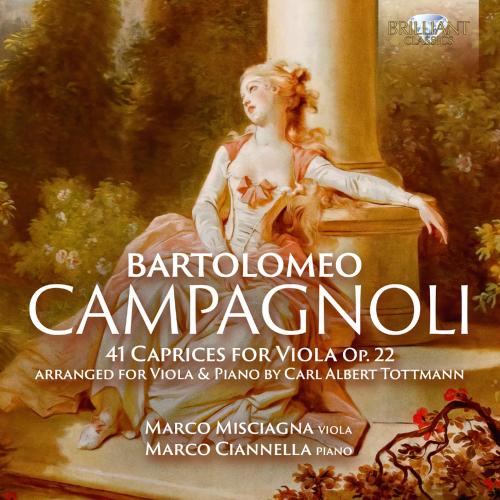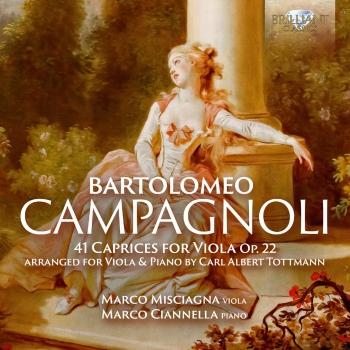
Campagnoli: 41 Caprices for Viola, Op. 22, arranged for Viola & Piano by Carl Albert Tottmann Marco Misciagna & Marco Ciannella
Album Info
Album Veröffentlichung:
2022
HRA-Veröffentlichung:
26.10.2022
Label: Brilliant Classics
Genre: Classical
Subgenre: Chamber Music
Interpret: Marco Misciagna & Marco Ciannella
Komponist: Bartolomeo Campagnoli (1751-1827)
Das Album enthält Albumcover
- Bartolomeo Campagnoli (1751 - 1827): 41 Caprices for Viola, Op. 22:
- 1 Campagnoli: 41 Caprices for Viola, Op. 22: I. Largo - Allegro 02:41
- 2 Campagnoli: 41 Caprices for Viola, Op. 22: II. Andante con moto - Piu Moto 02:06
- 3 Campagnoli: 41 Caprices for Viola, Op. 22: III. Allegro Moderato 01:25
- 4 Campagnoli: 41 Caprices for Viola, Op. 22: IV. Andante Maestoso 01:48
- 5 Campagnoli: 41 Caprices for Viola, Op. 22: V. Allegro Moderato 02:42
- 6 Campagnoli: 41 Caprices for Viola, Op. 22: VI. Adagio 02:25
- 7 Campagnoli: 41 Caprices for Viola, Op. 22: VII. Tempo Giusto 01:59
- 8 Campagnoli: 41 Caprices for Viola, Op. 22: VIII. Largo 04:36
- 9 Campagnoli: 41 Caprices for Viola, Op. 22: IX. Allegro 01:06
- 10 Campagnoli: 41 Caprices for Viola, Op. 22: X. Adagio Amoroso 03:20
- 11 Campagnoli: 41 Caprices for Viola, Op. 22: XI. Allegro 01:13
- 12 Campagnoli: 41 Caprices for Viola, Op. 22: XII. Allegro Assai 00:52
- 13 Campagnoli: 41 Caprices for Viola, Op. 22: XIII. Allegro 01:58
- 14 Campagnoli: 41 Caprices for Viola, Op. 22: XIV. Preludium - Adagio 03:51
- 15 Campagnoli: 41 Caprices for Viola, Op. 22: XV. Allegro Moderato 01:29
- 16 Campagnoli: 41 Caprices for Viola, Op. 22: XVI. Tempo a Piacere 02:59
- 17 Campagnoli: 41 Caprices for Viola, Op. 22: XVII. Andantino con Variazioni 07:33
- 18 Campagnoli: 41 Caprices for Viola, Op. 22: XVIII. Presto 02:02
- 19 Campagnoli: 41 Caprices for Viola, Op. 22: XIX. Tempo a Piacere 01:49
- 20 Campagnoli: 41 Caprices for Viola, Op. 22: XX. Tempo a Piacere 01:02
- 21 Campagnoli: 41 Caprices for Viola, Op. 22: XXI. Alla polacca e Trio 02:58
- 22 Campagnoli: 41 Caprices for Viola, Op. 22: XXII. Allegro Vivace 02:10
- 23 Campagnoli: 41 Caprices for Viola, Op. 22: XXIII. Andante Sostenuto 01:30
- 24 Campagnoli: 41 Caprices for Viola, Op. 22: XXIV. Adagio grandioso - Allegro - Adagio - Allegro 02:48
- 25 Campagnoli: 41 Caprices for Viola, Op. 22: XXV. Andantino con Variazioni 01:14
- 26 Campagnoli: 41 Caprices for Viola, Op. 22: XXVI. Adagio 05:56
- 27 Campagnoli: 41 Caprices for Viola, Op. 22: XXVII. Allegro non Troppo 01:18
- 28 Campagnoli: 41 Caprices for Viola, Op. 22: XXVIII. Allegretto 04:43
- 29 Campagnoli: 41 Caprices for Viola, Op. 22: XXIX. Allegro Assai 02:32
- 30 Campagnoli: 41 Caprices for Viola, Op. 22: XXX. Andante con Moto 02:51
- 31 Campagnoli: 41 Caprices for Viola, Op. 22: XXXI. Presto 04:18
- 32 Campagnoli: 41 Caprices for Viola, Op. 22: XXXII. Larghetto 01:33
- 33 Campagnoli: 41 Caprices for Viola, Op. 22: XXXIII. Allegro 01:49
- 34 Campagnoli: 41 Caprices for Viola, Op. 22: XXXIV. Andantino - Presto 01:32
- 35 Campagnoli: 41 Caprices for Viola, Op. 22: XXXV. Allegretto Scherzando 03:19
- 36 Campagnoli: 41 Caprices for Viola, Op. 22: XXXVI. Moderato Assai 01:59
- 37 Campagnoli: 41 Caprices for Viola, Op. 22: XXXVII. Vivace 02:47
- 38 Campagnoli: 41 Caprices for Viola, Op. 22: XXXVIII. Allegro Assai 06:44
- 39 Campagnoli: 41 Caprices for Viola, Op. 22: XXXIX. Larghetto 03:39
- 40 Campagnoli: 41 Caprices for Viola, Op. 22: XL. Vivace Assai 03:40
- 41 Campagnoli: 41 Caprices for Viola, Op. 22: XLI. Allegro Maestoso 03:12
Info zu Campagnoli: 41 Caprices for Viola, Op. 22, arranged for Viola & Piano by Carl Albert Tottmann
The considerable fame that Bartolomeo Campagnoli (1751–1827) achieved during his own lifetime was largely due to his contribution to violin studies. The 41 Caprices he wrote for viola and the 7 Divertimenti for solo violin are still in use today. Campagnoli’s career as a concert performer began in Rome in 1775, continuing in a long tour of the courts of the capital cities of Europe. In 1797 he was made concert director and first violin at the Gewandhaus in Leipzig, a post that he held until 1818, although he also maintained his contacts with the most advanced and influential cultural centres of Europe. He thus enjoyed a florid exchange with some of the most famous teachers and Nevertheless, there is an unmistakably composers of the time, in particular with Cherubini and Kreutzer. The idea that ‘true expression depends on the sound, intonation, movement, taste and aplomb of the measure’ was a constant tenet with Campagnoli, as was his insistence on the need to understand clearly the character of each piece in order to appreciate to the full the composer’s intentions. All this required respect for the exact point in which embellishments have to be added (without exceeding), because: ‘nothing is more beautiful and moving than what is simple’.
Karl Albert Tottmann (1837–1917) was a German musician and composer. Leaving the Leipzig Conservatory, he entered as first violin of the Gewandhaus Orchestra and in 1868 he was named director of the Vieux Théâtre Orchestra, remaining in this role until the end of 1872. Campagnoli’s 41 Caprices for viola were published in Leipzig around 1815, with Tottmann later adding a piano accompaniment. Capriccio No.17, a theme with variations in E minor, is the most musical and consistent of the collection and is particularly suitable for a performance as a concert piece; an alternative piano accompaniment for this caprice was later created and published by Grażyna Bacewicz. The 41 Caprices are the most important and well-known compositions by Campagnoli and one of the most important collections of violistic teaching. The studies deal with a wide category of technical issues for the left hand and for the bow, covering the problems of the solo, chamber and orchestral repertoire of the time, to the point of being defined as the ‘Kreutzer-Fiorillo’ of the viola. In studies Nos. 19 and 20 we find scales and arpeggios, in No.7 the slurred staccato. Octaves and other intervals, string jumps and arpeggios characterise Nos. 16, 17, 37; and the thirds and sixths are dealt with in Study No.2. The study of the cantabile is also very important, and in numerous caprices the rapid and technical part is preceded by a slow introduction which involves much legato and double chords (Nos. 1, 2, 24, 34). Many of the caprices end on the dominant, and this allows in many cases an immediate harmonic connection between one capriccio and the next.
Bartolomeo Campagnoli (1751-1827) learned his trade with Paul Guastarobba, a student of the famous Tartini, and with Petro Nardini. As a virtuoso on the violin he traveled Europe, where he held several important posts in Freising (Bavaria), Dresden and Stockholm, before settling as Konzertmeister of the famous Gewandhausorchester in Leipzig.
Campagnoli claimed for himself “the German learnedness with Italian soul”, and his works abound in lyrical melodies set into the firm musical structures of the first Viennese School.
The 41 caprices for viola were published in Leipzig around 1815, shortly after Hoffmeister's 12 studies for viola. It is one of the most important and well-known compositions by Campagnoli and one of the most important collections of violistic teaching. The studies deal with a wide category of technical issues for the left hand and for the bow, covering the problems of the solo, chamber and orchestral repertoire of the time, to the point of being defined as the "Kreutzer-Fiorillo” of the viola.
Karl Albert Tottmann (1837-1917) created a piano accompaniment for the caprices, which we hear on this recording. Capriccio no. 17, a theme with variations in E minor, is the most musical and consistent of the collection and became a favourite concert piece.
Played by Marco Misciagna (viola) and Marco Ciannella (piano). Marco Misciagna is one of the leading viola players of our time. He performed in the most famous concert halls of Europe such as the Berliner Philarmonie, Essen Philarmonie, Hamburg Laeiszhalle, Mannheim Rosengarten, Meistersingerhalle Nuremberg, Prinzregententheater Munich, Arriaga Theatre in Bilbao, Musikverein in Wien and in the most prestigious halls of America.
Marco Misciagna, viola
Marco Ciannella, piano
Marco Misciagna
Bereits mit 15 Jahren erwirbt der 1984 geborene Marco Misciagna sein Diplom in Violine und Viola am Staatlichen Konservatorium »N. Piccinni« in Bari, ein Diplom mit Auszeichnung erhält er anschließend am Conservatorio di Musica Santa Cecilia in Rom.
Auch sein weiterer Weg ist gepflastert mit Erfolgen. Neben vielen weiteren Auszeichnungen erhält er unter anderem zweifach den Preis »Monte dei Paschi di Siena« – als bester Violinist und gleichzeitig bester Violavirtuose. Auch am renommierten Internationalen Paganini-Violin-Wettbewerb in Moskau nimmt er – als einziger Italiener – erfolgreich teil.
Als Soloviolinist überzeugt er Publikum und Kritiker bei Auftritten mit verschiedenen italienischen und internationalen Orchestern. Auch in vielen namhaften Kammermusik-Ensembles wirkt er mit. Sein Repertoire reicht von der Klassik bis zur Moderne. Er spielt in den bedeutendsten Konzertsälen Europas und der USA. Er hat mehrere CDs eingespielt und eigene Viola Arrangements veröffentlicht.
Nach verschiedenen Professuren und Meisterkursen an internationalen Konservatorien und Musikhochschulen lehrt Marco Misciagna derzeit Viola am Staatlichen Konservatorium in Potenza / Italien, am Staatlichen Konservatorium in Tambov / Russland sowie an der Kunstakademie in Vladivostok / Russland.
Dieses Album enthält kein Booklet










